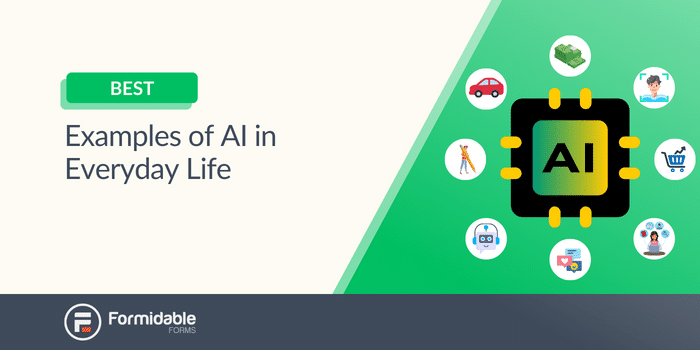
The tech world debates artificial intelligence’s consequences and its role in shaping our future. While many assume AI is still years away from significant impact, it’s already here, affecting decisions and lifestyles daily. Skeptical? Explore these 18 AI examples integrated into your daily life.
AI Examples in Your Daily Life (2024)
This article lists AI examples, both knowingly and unknowingly integrated into our lives. Click on the table below to navigate to specific sections.
1. Chatbots
Currently, we’re all familiar with using various chatbots online. From simple customer service bots to those mimicking human conversation, there’s a wide array. However, many of these bots you’ve been using actually utilize artificial intelligence.
An exemplary instance is ChatGPT. Initially perceived as just another online companion, it’s indeed an artificial intelligence-powered chatbot. ChatGPT operates on OpenAI’s large language model (GPT-3). Additionally, the company has introduced a newer model known as GPT-4, exclusive to Plus users.
The bot mimics human responses and performs various tasks. Initially used for conversations, it’s capable of much more.
ChatGPT writes blog posts, generates and debugs code, weaves stories, and provides recipes. With upcoming Internet access, thanks to OpenAI plugins, it’s a powerful tool. Whether you’re new to ChatGPT or a regular user, remember its significance in AI for 2024. Discover the endless possibilities and be amazed.
2. Microsoft Bing
Google has long dominated the search engine scene, but Microsoft has revamped Bing with artificial intelligence. The new AI Bing can provide nuanced responses intelligently. Additionally, Bing introduces Chat mode.
In Chat mode, Bing AI allows users to converse with the search engine and access various search results. Similar to ChatGPT, Bing can answer diverse questions and perform various tasks. Since its launch, MS Bing has gained immense popularity, boasting over 100 million daily active users. If you’re already using MS Bing AI, you’ve likely experienced its powerful artificial intelligence firsthand.
3. Google Duplex and Hold For Me
Google Duplex, an AI-based service, fully exploits AI’s potential. Initially showcased in 2018, Duplex can reserve restaurant tables autonomously, emulating human speech and grasping context to respond naturally. It facilitates various tasks such as booking movie tickets or salon appointments. Currently, this service is exclusively available in English and restricted to the US.
Additionally, Hold For Me, a recent addition to Pixel phones in the US, exemplifies AI’s integration into daily life, streamlining tasks significantly. For instance, when placed on hold after calling a toll-free number, Google Assistant manages the call, notifying you upon human availability, thus optimizing time usage.
4. Streamlined Writing Assistance: Smart Compose, Quick Reply, Grammar Check
If you’re a Gmail user, you may have encountered the Smart Compose feature. It efficiently suggests complete sentences based on your previous input, leveraging Artificial Intelligence for contextual accuracy and grammatical correctness. Personally, I find it remarkably helpful, exemplifying AI’s capacity to enhance productivity and save time. This feature is readily accessible within the Compose window. Simply tap the tab key to incorporate Smart Compose suggestions seamlessly into your draft.
Quick Reply, available in Gmail and messaging apps on Android, is powered by AI. For instance, in WhatsApp, quick replies appear atop notifications, tailored to the message. Tapping one sends an instant response, showcasing AI’s impact on online interactions.
Furthermore, Google Docs features Grammar Check, also AI-driven. Many utilize Google Docs for writing, and Google employs AI to enhance sentence accuracy. While the service is default, manual activation is possible via Tools -> Spelling and Grammar. In addition to Google, Grammarly and various alternatives offer AI-based grammar checks.
5. Google Recorder, Live Captions, and Transcribe
AI’s prime application lies in speech detection, exemplified by Google Recorder and Otter.ai. These platforms utilize AI to transcribe speeches instantly. Google Recorder, in particular, employs Machine Learning to transcribe speeches offline with high precision. It also generates searchable notes for convenient editing.
Google introduced Live Caption on Android and Chrome browsers, enabling real-time captioning of internal audio using AI. Presently, Live Captions exclusively support English. Additionally, Google offers the Live Transcribe app, which transcribes speeches in over 80 languages, detecting surrounding sounds like fire alarms or doorbells, aiding individuals with hearing impairments.
6. Google Lens and OCR
Google Lens, a Google service rooted in AI, boasts remarkable optical recognition technology. It enables image-based searches effortlessly. Simply aim your camera at a shoe, plant, animal, or text, and it swiftly identifies the subject, delivering precise information within seconds. This feat owes itself to AI’s strides in optical recognition.
Google Lens offers OCR functionality, enabling easy text extraction from images. Most OCR software, including Tesseract and TensorFlow, utilizes AI to detect characters in images. Applications like Adobe Scan and Microsoft Office Lens utilize AI for smart cropping and edge detection.
7. Fall Detection and Car Crash Detection
Newer Apple Watches feature Fall Detection, which notifies emergency services upon detecting a hard fall using data from the accelerometer and gyroscope. AI algorithms enhance the accuracy of fall detection, contributing significantly to saving lives.
Google and Apple iPhones now include Car Crash Detection, utilizing Machine Learning models to identify real-life car crashes. Upon detecting a crash, the phone sends the location to selected contacts and alerts the response team. From software utilities to life-saving features, AI powers various aspects of our daily lives.
8. Social Media Feeds, Amazon, and Netflix Recommendations
Unfortunately, social media is heavily influenced by AI. Even if you’re oblivious, chances are you’re tweeting from beneath a rock. Whether it’s Twitter, Facebook, Instagram, Snapchat, or any other social media app, AI significantly influences your decisions.
Your timeline’s feeds and app notifications are curated by AI through complex algorithms, analyzing your past behavior, web searches, interactions, video watches, and more. Its sole purpose is to make apps addictive, ensuring your return.
Amazon’s recommendations, post-cart additions or based on browsing history, are AI-curated. Netflix recommendations, too, use AI to tailor movies and shows to your preferences.
9. Google Assistant and Camera
Long before ChatGPT or Bing, AI was in our hands. Regular smartphone use means interacting with AI, knowingly or not. From smart assistants to portrait mode, AI impacts our daily lives.
The provided examples offer insight into AI’s impact on our lives. Smart assistants like Google Assistant, Alexa, Siri, or Bixby are common AI applications. Yet, the role of AI in features like portrait mode in photography often goes unnoticed. Have you considered how Google Pixel or iPhones produce exceptional portrait shots? The answer lies in artificial intelligence.
Manufacturers increasingly integrate AI into smartphones, with major chip manufacturers like Qualcomm and Huawei producing chips featuring built-in AI capabilities. This integration enhances features such as scene detection, mixed and virtual reality elements, and more. AI’s significance is poised to grow further in the future, evident in the emphasis on AI in recent Android and iOS updates.
10. AI Image Generators
Having perused the aforementioned, you must be cognizant of AI’s prowess in visual media. While OCR scanning can convert real-world objects to text intelligently, AI integration in portrait mode enhances image composition. However, were you aware that in 2024, you can generate full-fledged images through AI? The emergence of AI has simplified image creation significantly. Users require imagination but solely to generate prompts for AI image generators. These generators utilize a blend of AI technologies to create a diverse array of images.
Mentioned earlier, generators only require prompts, thus limited by imagination. AI image generators, such as Midjourney, excel at producing vivid, beautiful images. As evident above, AI-created images match or exceed those crafted by artists. Should this trend persist, AI may one day rival the creative industry. Meanwhile, numerous such generators are available. Explore the top AI art generators and experiment firsthand.
11. Autonomous Vehicles
Discussing AI, few examples rival the prowess demonstrated by smart car manufacturers. Previously, fully automatic cars existed solely in imagination. Yet, companies such as Tesla have rapidly advanced, furnishing roads with a fleet of semi-automatic vehicles.
Tesla cars exemplify AI’s impact on daily life. Did you know all Tesla cars are interconnected, sharing learned experiences? If your car makes an unexpected hard left, others will learn to navigate it after updates. Over 500,000 Teslas operate in the US, a number set to soar with production issues resolved. With autonomous cars on roads and drones in skies, AI’s influence is undeniable.
12. Music and Media Streaming Services
AI significantly influences our daily lives through music and media streaming services such as Netflix. Whether utilizing Spotify or YouTube, AI dictates choices, often subtly. Despite feeling autonomous, a prime illustration is the Discover Weekly playlist, where Spotify employs AI and ML to seamlessly integrate fresh artists and tracks.
Emerging AI features like Enhance add similar songs to your playlist. It’s all AI. YouTube, with its recommendations, does the same by analyzing your data and behavior. So, when you’re enjoying recommended content on YouTube, Netflix, Spotify, or any other streaming service, know that AI is at work.
13. Video Games
The video game industry was an early adopter of AI. Initially used for generating random levels, AI integration has since expanded exponentially.
At a large scale, OpenAI 5, backed by Elon Musk’s company OpenAI, has surpassed pro-level Dota 2 players in one-on-one matches, as well as amateur teams. This accomplishment marks a significant advancement in the AI industry. Dota 2, a strategy-based game requiring rapid decision-making, presents a substantial challenge for AI, making this feat remarkable.
Video games have long incorporated AI elements. When playing games like PUBG or Fortnite, you start against AI-powered bots before facing real players. Even in single-player story mode games, you contend with AI bosses.
Racing games pit you against AI bots. The Middle Earth series showcases AI-controlled enemies that evolve based on interactions with players and other game elements. The integration of AI in games extends far beyond these examples.
14. Navigation and Travel
AI significantly impacts the navigation and travel industry, influencing our daily commutes and major trips alike. Whether utilizing Google or Apple Maps, calling an Uber, or booking a flight, AI is at work.
Both Google and Apple, alongside other navigation services, employ AI to analyze vast datasets for real-time traffic updates. When booking an Uber, AI determines both pricing and vehicle selection to match your ride request. Clearly, AI is integral to modern transportation.
15. Security and Surveillance
Debating the ethics of broad surveillance notwithstanding, its prevalence and the substantial role of AI within it are undeniable. Humans cannot feasibly monitor numerous camera feeds simultaneously, hence the logical employment of AI.
Technological advancements, particularly in object and facial recognition, continue to progress rapidly. Soon, AI will likely entirely replace human monitoring of security camera feeds. The transition may not be immediate, but it is inevitable.
Facial Recognition
Facial recognition technology, intertwined with AI, streamlines phone unlocking. Take Apple’s Face ID, for instance, which meticulously maps your face using thousands of invisible dots, along with capturing an infrared image. This fusion of hardware and AI empowers facial recognition to perceive depth in 3D. Hence, each time you unlock your device, you’re essentially engaging with artificial intelligence.
17. Smart Speakers
If you thought Google and Siri were confined to phones, think again. Many believe smart speakers are poised for a technological boom. Apart from basic functions, they employ AI to interpret speech and execute commands. Besides managing smart home devices, they facilitate tasks like sending messages, setting reminders, checking the weather, and accessing news updates. Their versatility is proving pivotal.
Led by Amazon Echo and Apple Homepod series, the global smart speaker market is projected to hit US$ 27.92 billion by 2028. Smart speakers epitomize the integration of artificial intelligence into our daily lives.
18. Adaptive Battery/Charging
Did you know that adaptive charging on your phone utilizes AI? It may surprise you to learn that this has been the case for quite some time. Adaptive battery, found on Android phones since Android 9, intelligently learns your usage patterns to optimize apps. This feature harnesses Google’s Deepmind AI technology.
Adaptive charging intelligently learns your usage patterns, aiming to maximize your iPhone’s battery lifespan. It stops charging at 80%, waiting until needed to top off the rest, utilizing a blend of AI and ML. AI’s influence in our lives is evident even before we realize it.
The Present and Future of Artificial Intelligence
Our lives are constantly influenced by artificial intelligence. Whether using smartphones, browsing the internet, shopping online, navigating, indulging in social media, or streaming music, AI shapes our decisions. What are your thoughts on AI’s impact? Share in the comments!

Pritam Chopra is a seasoned IT professional and a passionate blogger hailing from the dynamic realm of technology. With an insatiable curiosity for all things tech-related, Pritam has dedicated himself to exploring and unraveling the intricacies of the digital world.



